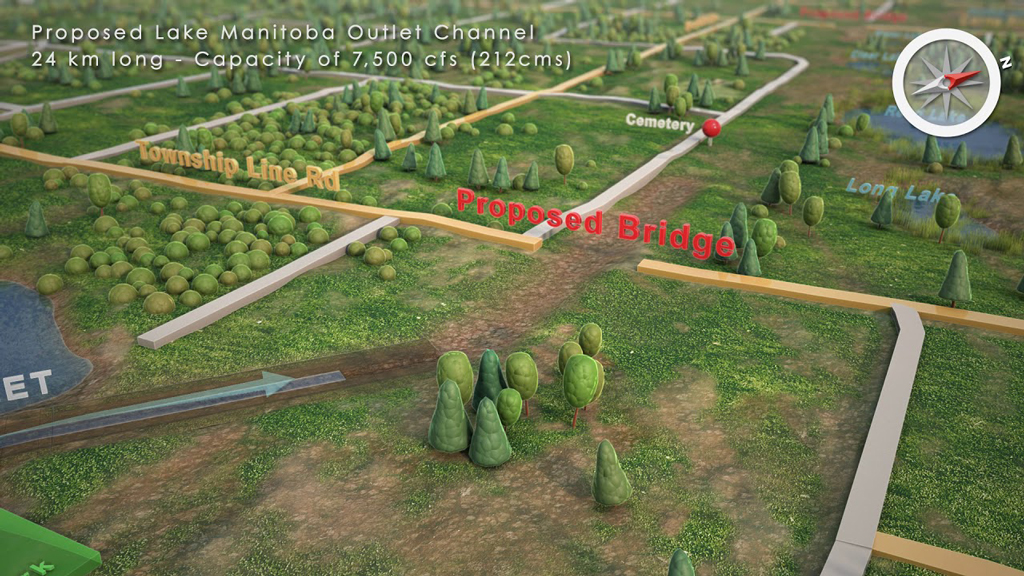The Impact Assessment Agency of ∫⁄¡œ≥‘πœÕ¯ (IAAC) is in the process of mulling over supplementary information that was filed by Manitoba’s Ministry of Transportation and Infrastructure (MTI) as part of an environmental assessment of the proposed Lake Manitoba/Lake St. Martin Outlet Channels Project.
MTI submitted an updated project description and more information on environmental management plans for the project last year.
The IAAC had asked MTI for the additional information after conducting a review of an Environmental Impact Statement (EIS) that was submitted in March 2020 in order to help the agency better understand possible adverse environmental effects the project might cause.
The MTI submission is intended to clarify and consolidate refinements made to the estimated $600-million project.
‚ÄúThe proposed Outlet Channels Project is still undergoing provincial and federal environmental assessment, including completing a number of information requests from the Impact Assessment Agency of ∫⁄¡œ≥‘πœÕ¯,‚Äù says a statement prepared for Journal of Commerce by a spokesperson for the MTI.
“After IAAC completes its review process of MTI’s most recent submission, IAAC will determine if additional information requests will be issued to MTI. Therefore, timelines for regulatory approvals remain uncertain at this time.”
Contractors had originally anticipated tenders to be issued in spring 2022. The MTI submitted technical information to the IAAC in May that year, but the agency decided it needed more information. Specifically, it wanted more details on the consultation and engagement process as well as potential downstream effects of the project, climate resiliency of major components, and whether water quality would be affected.
The MTI spokesperson stated the refinements are part of any standard planning and environmental review process.
Under the proposed plan, two diversion channels, each roughly 24 kilometres long, would be built. The Lake Manitoba Outlet Channel will run northwards from Watchorn Bay on Lake Manitoba to Birch Bay on Lake St. Martin and includes a water control structure and three bridges and realignment of municipal roads. The Lake St. Martin Outlet Channel will run northeast from Lake St. Martin to Lake Winnipeg, south of Willow Point. The project would include the construction of two combined bridge and water control structures, a 24-kilovolt distribution line, and re-alignment and/or construction of provincial highways, municipal roads and three bridge structures.
The goal of the project is to prevent a repeat of extensive flooding that forced thousands from their homes in First Nations communities in 2011. The two channels will enable the province to regulate water levels on the two lakes.
The area is prone to flooding because of its typography and location, with water moving from the Rocky Mountains in the northern United States and boreal forests through northern Manitoba on the way to Hudson Bay.
The MTI spokesperson stated the project will allow for more effective management of water levels on both lakes.
‚ÄúThe need for this proposed project will improve Manitoba’s climate resiliency.‚Äù
Some prep work has already taken place. An access road was completed in March 2022. Ironically, the road was damaged by flooding and had to be repaired. Some failed culverts and embankment side slopes were also fixed.
Once the project gets underway, an estimated 600 to 900 construction workers are expected to be involved throughout the construction period.
Work will entail tree clearing, excavation, peat moss removal, riprap placement, and realignments and paving of PR 239 and municipal roads. Additionally, new municipal roads will be constructed.
“Work on both projects will start at the same time,” the MTI spokesperson stated. “MTI expects the projects to take three to four years of construction.”
Construction work will proceed in a sequenced approach, involving multiple contracts. Every year, MTI will tender construction contracts in alignment with the planned construction sequencing.
Construction is expected to take three years to complete. The venture is one of the largest in Manitoba’s history.
The project will not be without its challenges, though, according to the MTI spokesperson.
A number of construction challenges have been identified, including environmental requirements and constraints, local workforce capacity, existing conditions such as ground and surface water management, access to construction sites and the number of construction contracts, the spokesperson states.
“MTI has identified mitigation measures to manage these challenges such as incorporating environmental requirements into the design, scheduling construction activities with consideration of environmental restrictions, sequencing construction activities to minimize existing condition impact and breaking down the project into smaller contracts to suit local contractor’s capacity.”
While waiting for the IAAC to rule, the province is working with Indigenous communities and groups to iron out any issues they might have.
So far, MTI has met with 39 Indigenous communities and groups that may be affected by the proposed project and established an ongoing consultation and engagement process.
“Communications with Indigenous groups will continue after the anticipated receipt of regulatory approvals and throughout the construction phase,” the MTI spokesperson noted. “The primary goal of consultation and engagement with Indigenous groups is to share information about the proposed project and its potential effects.
“It is also to gather Indigenous knowledge to better understand, avoid, and/or reduce effects on Indigenous and treaty rights.”



Recent Comments
comments for this post are closed